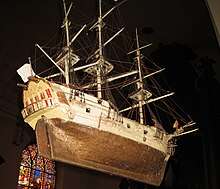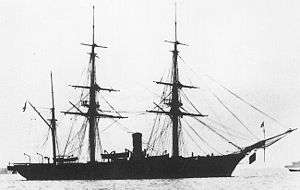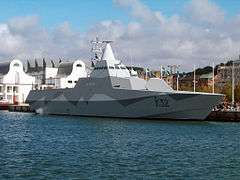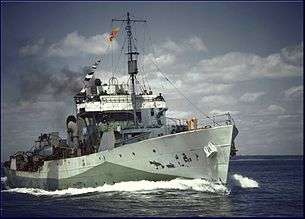Corvette
A corvette is a small warship. It is traditionally the smallest class of vessel considered to be a proper (or "rated") warship. The warship class above the corvette is that of the frigate, while the class below was historically that of the sloop-of-war. The modern types of ship below a corvette are coastal patrol craft, missile boat and fast attack craft. In modern terms, a corvette is typically between 500 tons and 2,000 tons, although recent designs may approach 3,000 tons, which might instead be considered a small frigate.
.jpg)
The word "corvette" is first found in Middle French, a diminutive of the Dutch word corf, meaning a "basket", from the Latin corbis.[1]
The rank "corvette captain", equivalent in many navies to "lieutenant commander", derives from the name of this type of ship. The rank is the most junior of three "captain" ranks in several European (e.g., France, Spain, Italy, Croatia) and South American (e.g., Argentina, Chile, Brazil) navies, because a corvette, as the smallest class of rated warship, was traditionally the smallest class of vessel entitled to a commander of a "captain" rank.
Sailing vessels

During the Age of Sail, corvettes were one of many types of warships smaller than a frigate and with a single deck of guns.[2] They were very closely related to sloops-of-war. The role of the corvette consisted mostly of coastal patrol, fighting minor wars, supporting large fleets, or participating in show-the-flag missions. The English Navy began using small ships in the 1650s, but described them as sloops rather than corvettes. The first reference to a corvette was with the French Navy in the 1670s, which may be where the term originated. The French Navy's corvettes grew over the decades and by the 1780s they were ships of 20 guns or so, approximately equivalent to the British Navy's post ships. The British Navy did not adopt the term until the 1830s, long after the Napoleonic Wars, to describe a small sixth-rate vessel somewhat larger than a sloop.
The last vessel lost by France during the American Revolutionary War was the corvette Le Dragon, scuttled by her captain to avoid capture off Monte Cristi, Haïti in January 1783.[3]
Most corvettes and sloops of the 17th century were around 40 to 60 ft (12 to 18 m) in length and measured 40 to 70 tons burthen. They carried four to eight smaller guns on a single deck. Over time, vessels of increasing size and capability were called corvettes; by 1800, they reached lengths of over 100 ft (30 m) and measured from 400 to 600 tons burthen.
Steam ships

Ships during the steam era became much faster and more maneuverable than their sail ancestors. Corvettes during this era were typically used alongside gunboats during colonial missions. Battleships and other large vessels were unnecessary when fighting the indigenous people of the Far East and Africa.
World War II
The modern corvette appeared during World War II as an easily-built patrol and convoy escort vessel.[2] The British naval designer William Reed drew up a small ship based on the single-shaft Smiths Dock Company whale catcher Southern Pride, whose simple design and mercantile construction standards lent itself to rapid production in large numbers in small yards unused to naval work. First Lord of the Admiralty Winston Churchill, later Prime Minister, had a hand in reviving the name "corvette".
During the arms buildup leading to World War II, the term "corvette" was almost attached to the Tribal-class destroyer. The Tribals were so much larger than and sufficiently different from other British destroyers that some consideration was given to resurrecting the classification of "corvette" and applying it to them. This idea was dropped, and the term applied to small, mass-produced antisubmarine escorts such as the Flower class of World War II.
The first modern corvettes were the Flower class (Royal Navy were named after flowers, and ships in Royal Canadian Navy service took the name of smaller Canadian cities and towns). Their chief duty was to protect convoys throughout the Battle of the Atlantic and on the routes from the UK to Murmansk carrying supplies to the Soviet Union.
The Flower-class corvette was originally designed for offshore patrol work, and was not ideal when pressed into service as an antisubmarine escort. It was shorter than ideal for oceangoing convoy escort work, too lightly armed for antiaircraft defense, and the ships were barely faster than the merchantmen they escorted. This was a particular problem given the faster German U-boat designs then emerging. Nonetheless the ship was quite seaworthy and maneuverable, but living conditions for ocean voyages were challenging. As a result of these shortcomings, the corvette was superseded in the Royal Navy as the escort ship of choice by the frigate, which was larger, faster, better armed, and had two shafts. However, many small yards could not produce vessels of frigate size, so an improved corvette design, the Castle class, was introduced later in the war, with some remaining in service until the mid-1950s.
The Royal Australian Navy built 60 Bathurst-class corvettes, including 20 for the Royal Navy crewed by Australians, and four for the Indian Navy. These were officially described as Australian minesweepers, or as minesweeping sloops by the Royal Navy, and were named after Australian towns.
The Bird-class minesweepers or trawlers were referred to as corvettes in the Royal New Zealand Navy, and two, Kiwi and Moa, rammed and sank a much larger Japanese submarine, I-1, in 1943 in the Solomon Islands.
In Italy, the Regia Marina, in dire need of escort vessels for its convoys, designed the Gabbiano-class corvette, of which 29 were built between 1942 and 1943 (out of 60 planned); they proved apt at operations in the Mediterranean Sea, especially in regards to their anti-air and anti-submarine capability, and were so successful that the class survived after the war into the Marina Militare Italiana until 1972.
Modern corvettes
Modern navies began a trend in the late 20th and early 21st centuries towards smaller more manoeuverable surface capability. Corvettes have a displacement between 500 and 3,000 long tons (510 and 3,050 t) and measure 180–420 ft (55–128 m) in length. They are usually armed with medium- and small-calibre guns, surface-to-surface missiles, surface-to-air missiles (SAM), and anti-submarine weapons. Many can accommodate a small or medium anti-submarine warfare helicopter.
Most countries with coastlines can build corvette-sized ships, either as part of their commercial shipbuilding activities or in purpose-built yards, but the sensors, weapons, and other systems required for a surface combatant are more specialized and are around 60% of the total cost. These components are purchased on the international market.[4]
Current corvette classes
Many countries today operate corvettes; some include Argentina,[5] Bangladesh, Brazil, Bulgaria, China, Germany, Egypt, India, Indonesia, Iran, Israel, Italy, Norway, Pakistan, the Philippines, Poland, Portugal, Romania, Russia, Singapore, South Korea, Sweden, Malaysia, Turkey, United Arab Emirates and United States. Countries that border smaller seas, such as the Baltic Sea or the Persian Gulf, are more likely to build the smaller and more manoeuvrable corvettes, with Russia operating the most corvettes in the world.
.jpg)

In the 1960s, the Portuguese Navy designed the João Coutinho-class corvettes as multi-role small frigates intended to be affordable for a small navy. The João Coutinho class would soon inspire a series of similar projects – including the Spanish Descubierta, the German MEKO 140, the French A69 and the own Portuguese Baptista de Andrade – adopted by a number of medium and small sized navies.
The first operational corvette based on stealth technology was the Royal Norwegian Navy's Skjold class. The Swedish Navy introduced the similarly stealthy Visby class.
The United States is developing littoral combat ships, which are essentially large corvettes, their spacious hulls permitting space for mission modules, allowing them to undertake tasks formerly assigned to specialist classes such as minesweepers or the anti-submarine Oliver Hazard Perry-class frigate.
The Israeli Navy operates three Sa'ar 5-class corvettes. Built in the U.S to an Israeli design, they carry one helicopter and are well-armed with offensive and defensive weapons systems, including the Barak 8 SAM, and advanced electronic sensors and countermeasures. They displace over 1,200 tons at full load.
The Indian Navy operates four Kamorta-class corvettes built by Garden Reach Shipbuilders and Engineers. All of them were in service by 2017.
The new German Navy Braunschweig class is designed to replace Germany's fast attack craft and also incorporates stealth technology and land attack capabilities. The Israeli Navy has ordered four Sa'ar 6-class corvettes, a more heavily armed version of the type, deliveries commencing in 2019.
Turkey began to build MİLGEM-class corvettes in 2005. The MİLGEM class is designed for anti-submarine warfare and littoral patrol duty. The lead ship, TCG Heybeliada, entered navy service in 2011. The design concept and mission profile of the MİLGEM class is similar to the Freedom class of littoral combat ships of the United States.
Finland has plans to build four multi-role corvettes, currently dubbed the Pohjanmaa-class, in the 2020s as part of its navy's Project Squadron 2020. The corvettes will have helicopter carrying, mine laying, ice breaking, anti-aircraft and anti-ship abilities. They will be over 100 metres (330 ft) long and cost a total of 1.2 billion euros.
The Greek Navy has categorised the class as fast attack missile craft. A similar vessel is the Kılıç-class fast attack missile craft of the Turkish Navy, which is classified as a corvette by Lürssen Werft, the German ship designer.
In 2004, to replace the Ardhana class patrol boat, the United Arab Emirates Ministry of Defence awarded a contract to Abu Dhabi Ship Building for the Baynunah class of corvettes. This class is based on the CMN Group's Combattante BR70 design. The Baynunah class is designed for patrol and surveillance, minelaying, interception and other anti-surface warfare operations in the United Arab Emirates territorial waters and exclusive economic zone. The lead ship was launched on June 25, 2009. Sea trials commenced in January 2010.
Museum ships
.jpg)
- ARA Uruguay, 1874 steam and sail barque, Buenos Aires, Argentina
- HMAS Castlemaine, 1941 Bathurst-class corvette, Williamstown, Victoria, Australia
- HMCS Sackville, 1941 Flower-class corvette, Halifax, Nova Scotia, Canada
- HMAS Whyalla, 1941 Bathurst-class corvette, Whyalla, South Australia, Australia
- Karjala, 1968 Turunmaa-class corvette, Turku, Finland
- Hiddensee, 1984 Tarantul-class missile corvette, Fall River, Massachusetts, US
- HTMS Maeklong in Samut Prakan Province, Thailand.
- ROKS Pohang (PCC-756), a Pohang-class corvette in Pohang, South Korea.
See also
- List of corvette classes
- List of corvette and sloop classes of the Royal Navy
- List of corvettes of the Second World War
- List of Escorteurs of the French Navy
- Corvette 31, a sailboat named in honour of the warship class.
References
- "corvette". Merriam-Webster. Retrieved 2011-08-13.
- Keegan, John (1989). The Price of Admiralty. New York: Viking. p. 277. ISBN 978-0-670-81416-9.
- Freddy Van Daele "The Enigmatic Ostend Model "The Dragon-1783"-Alfred Van Daele publisher September 2015
- Magnuson, Stew (16 May 2011). "East/West Divide Grows In the International Navy Shipbuilding Business". National Defense Industrial Association. Archived from the original on 2011-05-19.
- "Corbeta Clase Espora (Meko 140)" (in Spanish). Armada Argentina. Archived from the original on 28 November 2017. Retrieved 9 August 2019.
Further reading
- The collection Three Corvettes by Nicholas Monsarrat recounts the writer's World War II experiences on corvettes, starting as an inexperienced small-boat sailor and ending as captain.
- The novel The Cruel Sea (1951), also by Nicholas Monsarrat, about the life and death of a Flower-class corvette and the men in her, is regarded as one of the classic naval stories of World War II.
- James B. Lamb's two books, The Corvette Navy and On the Triangle Run, give an autobiographical and historical perspective of life on Royal Canadian Navy corvettes in World War II. The author served on them for six years from Halifax to the beaches of D-Day.
External links
| Wikimedia Commons has media related to Corvettes. |
| Look up corvette in Wiktionary, the free dictionary. |
